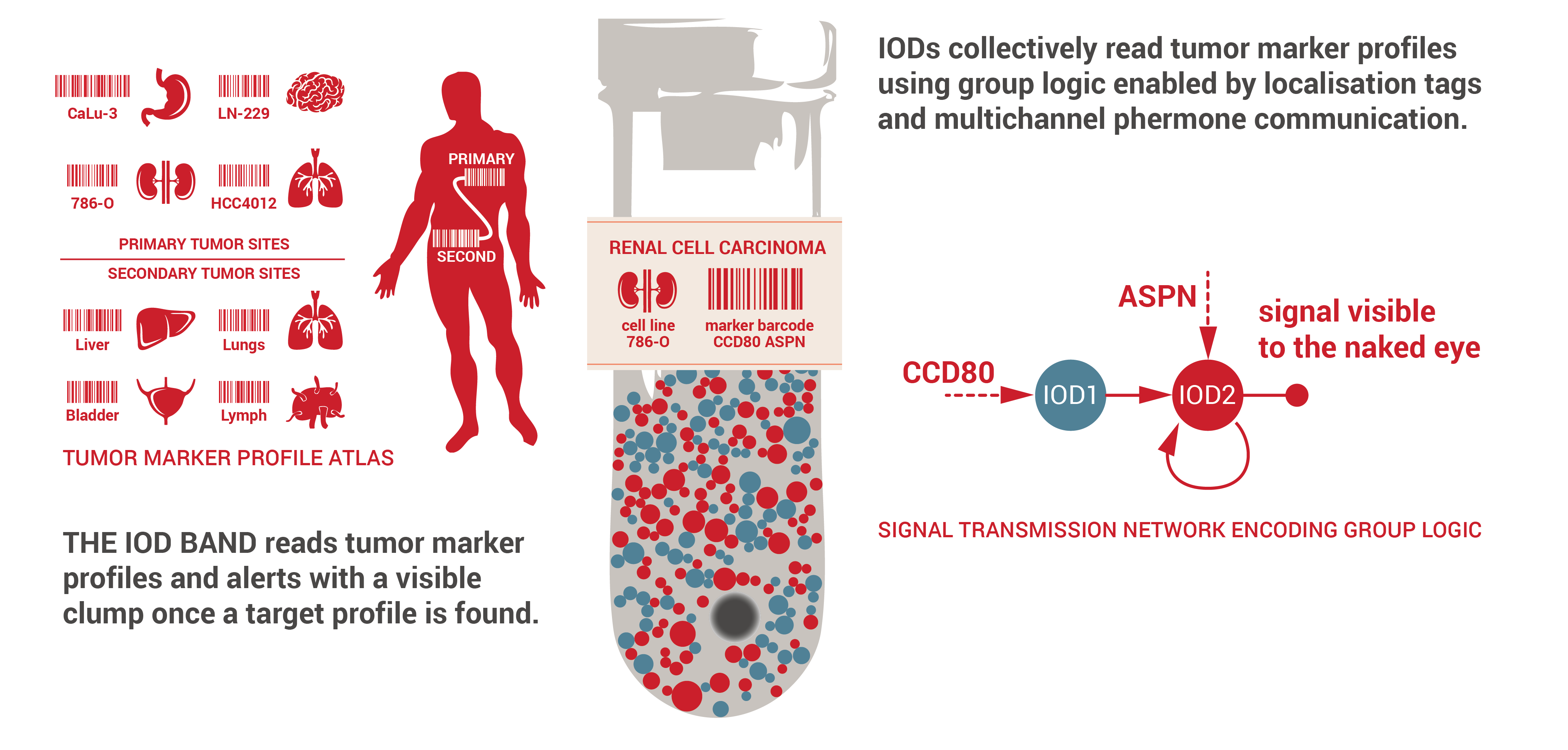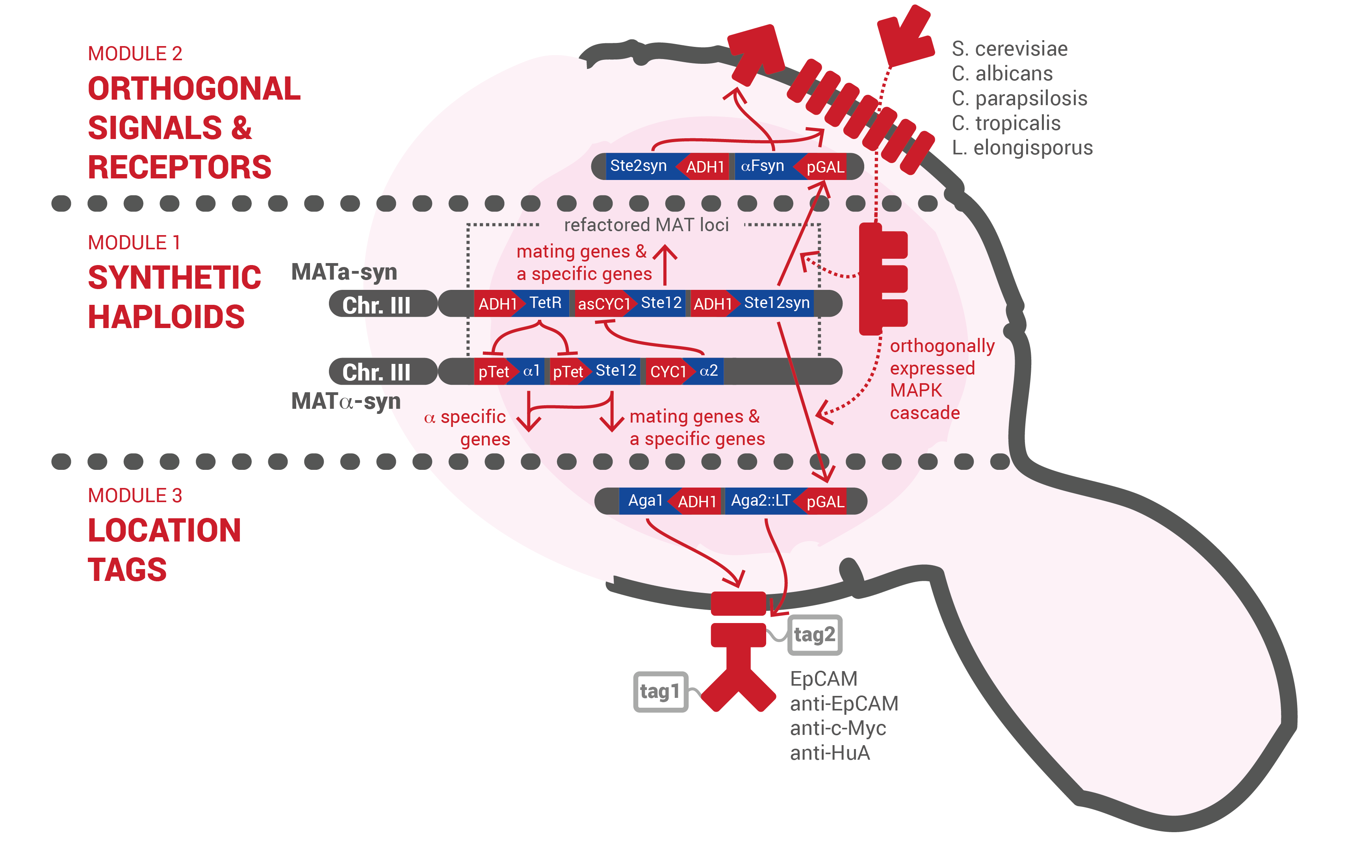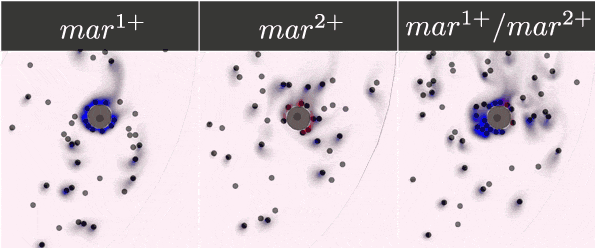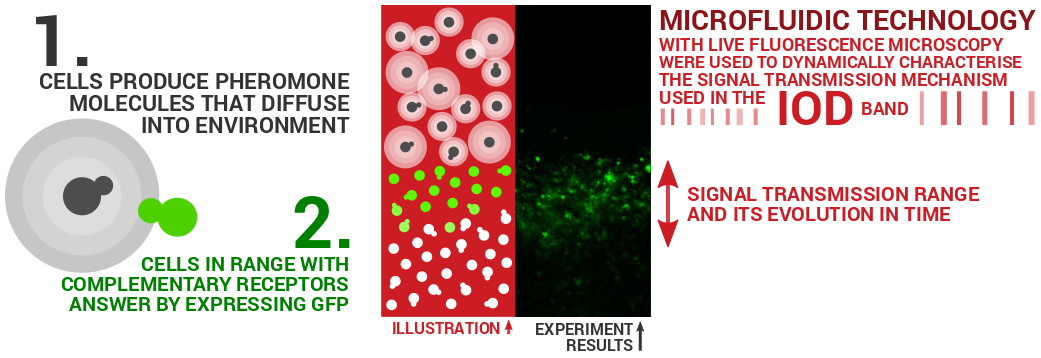Team:Czech Republic/Project
Project
Contents
Abstract
The IOD band is a general diagnostic test enabling early detection and mapping of tumor mobility. Over a billion unique tests are made accessible to field experts outside of synthetic biology with a unique clone-free assembly feature. Tumor mobility is incredibly difficult to diagnose due to the rarity of circulating tumor cells (CTCs) and the complexity of surface marker combinations. The IOD band strives to make it easy. The central players are processing units called Input Output Diploids or IODs. IODs use antigen recognition and intercellular communication to create a logical network by which even a single cell carrying the desired marker profile can be identified in a background of millions. Affirmative CTC localisation triggers a global response manifested by IOD initiated clumping at levels visible to the naked eye. As such, IOD bands do in a test tube what normally requires days to do in the lab.
Motivation
Tumor mobility is likely the most significant prognostic factor for all types of cancer. Contained primary tumors often present no symptoms, and if discovered early can be safely removed without needing subsequent chemotherapy. If left untreated, however, primary tumors spread through the lymphatic or blood circulatory systems to other parts of the body. Given enough time, cancer cells undergo transition and take on characteristics of cells from other organs. At this stage, the cells invade compatible organs and secondary tumors called Mets develop. Early mets are less diverse and still present hope for treatment. Later mets, however, are too diverse and are usually associated with terminal diagnoses.
The difference between early stage and late stage diagnosis can be staggering. The table below lists the survival rate differential between early and late diagnosis for common cancer types.
| Stage | Kidney | Breast | Lung | Colorectal | Skin | Prostate |
|---|---|---|---|---|---|---|
| Stage I | 81% | 100% | 45% | 92% | 86% | 100% |
| Stage IV | 8% | 22% | 1% | 11% | 15% | 28% |
The IOD band concept
At Team Czech Republic, we envisioned a tumor marker body atlas. A large number of tumor cell lines as well as healthy tissues of common secondary sites have well-documented surface marker profiles. A dataset of over 700 surface markers comprising of common receptors, transmembrane proteins, and channel families was processed to identify usable members with confirmed antibodies. Each cell line was then linked to a unique combination of up to three markers identified by a simple 6 or 9 digit barcode. We then envisioned The IOD Band, a marker profile probe that locates cells with target marker combinations in samples of peripheral blood.
The fundamental units of the IOD band are intelligent input/output diploid cells called IODs. An IOD is fundamentally simple, comprising two modular inputs and a single modular output. The inputs are locational tags displayed on the surface and pheromones detected by orthogonally expressed receptor and signaling pathway. The inputs combine to yield locally limited cell-cell communication. Pheromones are also the IOD outputs. A rewiring of the signaling pathway transcription factor connects the inputs with the outputs. Hence, a single IOD simply detects a pheromone signal and generates an orthogonal signal in response.
Design and Functional Prototype
The IOD band is a project built on system level integration. At the outset, it seemed like an impossible goal for a single iGEM project especially as there are no precedents for many of the system parts. So the idea was stripped to its brass tacks to uncover three fundamental modules that prove the diagnostic and engineering principles in a tractable manner.
Module 1 builds synthetic haploid strains with refactored mating loci that are conjugated to make a functional IOD. These strains have the wild-type mating phenotype and differentially express a reprogrammed signalling pathway in their diploid state proving the feasibility of the clone-free assembly concept.
Functional prototypes of both MATa and MATx synthetic haploid strains were constructed and experimentally validated. The successful construction and integration of the refactored loci was confirmed using traditional methods and proves the effectivity of the flanking homologous regions. The retained wild-type mating phenotype of both synthetic haploid strains was validated by direct mating tests where strains were crossed and plated onto minimal medium. This shows that the synthetic strains are easily conjugated. Differential expression of haploid-specific and mating-type specific genes with respect to the wild-type strains was validated by flow cytometry. Using the developed collection of reporter plasmids, it was shown that mating-type specific genes are expressed only in their respective haploid strains and that haploid-specific genes are expressed in both the haploid and diploid strains. This demonstrates that the signaling cascade can be used orthogonally in haploid strains for conjugation purposes and in diploid strains for IOD intercellular signal detection. For the first time in iGEM, the function of a tunable a-specific promoter (a hybrid of the CYC1 and a-specific operon domains) was also validated.
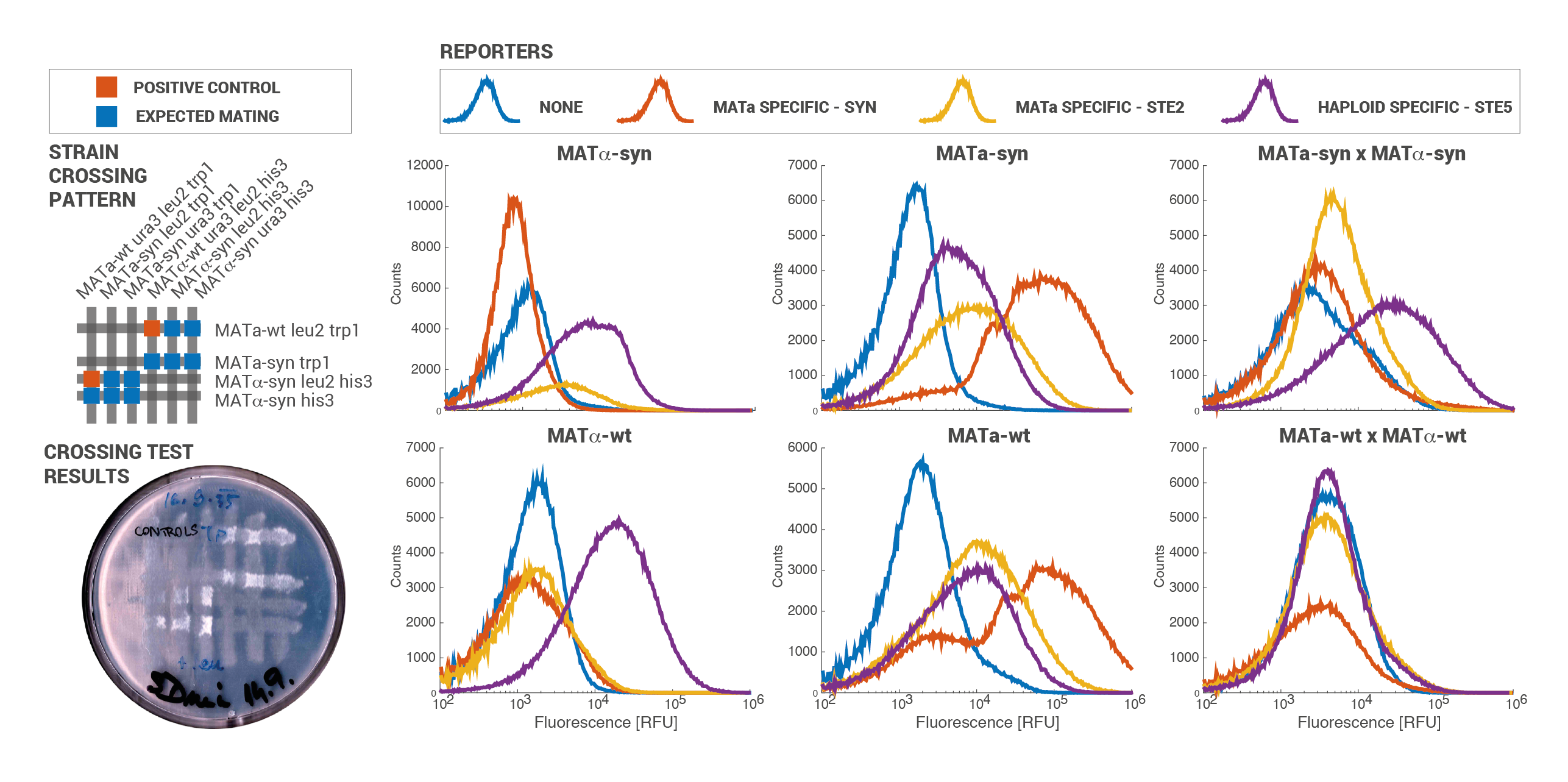
Module 2 builds a set of orthogonal pheromones and receptors. These pheromone-receptor pairs enable specific localized signalling proving the feasibility of multichannel signal transmission underlying logic operations necessary for reliable diagnosis.
For the first time, orthogonality of five different yeast pheromone-receptor pairs was validated. Alpha factor from various yeast strains was synthetically produced in S. cerevisiae and used to induce the pheromone pathway rewired with the corresponding Ste2 receptors. Fluorescence measurements from the pheromone pathway reporter pFUS1 showed maximal activation in matching pairs that significantly dominated any cross talk between the non-matching pairs. Furthermore, functionality of the synthetic sequences was extensively tested using both physiological and molecular assays. To prove the designed alpha factor, which was truncated to exclude repeats induces mating, a MATa cell synthetically expressing the alpha phermone was shown to schmoo after induction. To prove localization of pheromone based signalling to the immediate neighbourhood of the transmitting cell, a microfluidic experiment was designed that directly measured the signalling range in saturated cultures. An extrapolation of the results indicates that in a culture with OD600 greater than 3.0 only cells in direct contact will transmit signal.
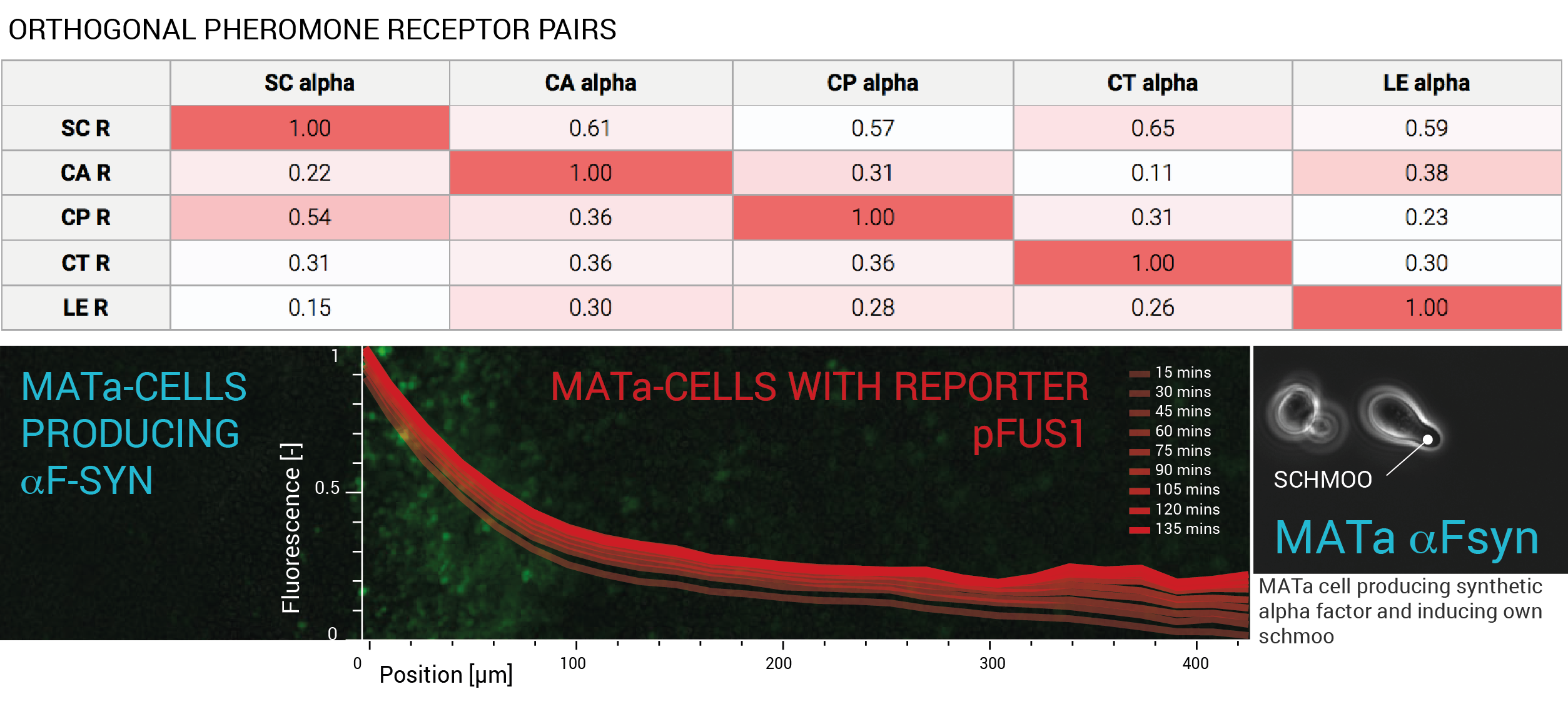
Module 3 builds a set of location tags that recognize common tumor surface markers and agglutinate cell populations. Location tags displayed in the correct conformation strengthen cell-cell interactions to enable localization of signal transmission.
For the first time, an antibody (anti-EpCam), the most commonly used CTC marker (EpCAM), and the human antigen A antibody (anti-HuA) were displayed on the surface of the cell wall. Successful construction of the display plasmids was confirmed using traditional methods. Successful epitope export and display were then validated by immunofluorescent staining using an upstream hemagglutinin tag. Clumping of cells with complimentary location tags (i.e., anti-EpCAM and Ep-CAM) was shown qualitatively using microscopy and by visual inspection of stained slides with mounted cultures. While all cells have a tendency to aggregate that varies with incubation period and temperature, cells displaying complimentary location tags always generated visibly larger aggregates than their controls. Functioning of location tags in plasma, which is the natural medium for the IOD band diagnostic, was further proven by cell clumping consistently observed in mixed samples of yeast cells with the anti-HuA location tag and red blood cells from a type A donor. The control samples, where anti-HuA location tag display was not induced, showed negligible aggregation. These experiments also prove the compatibility of yeast cells with blood samples as no significant clumping or other abnormalities that would indicate overall concept infeasibility were observed in control samples.
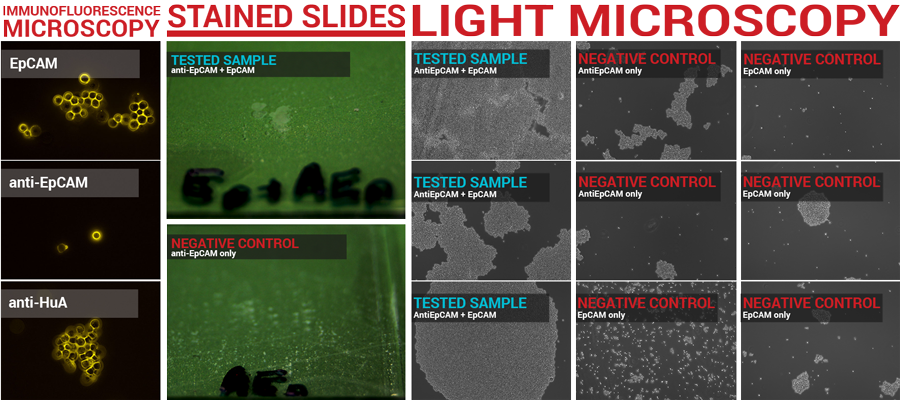
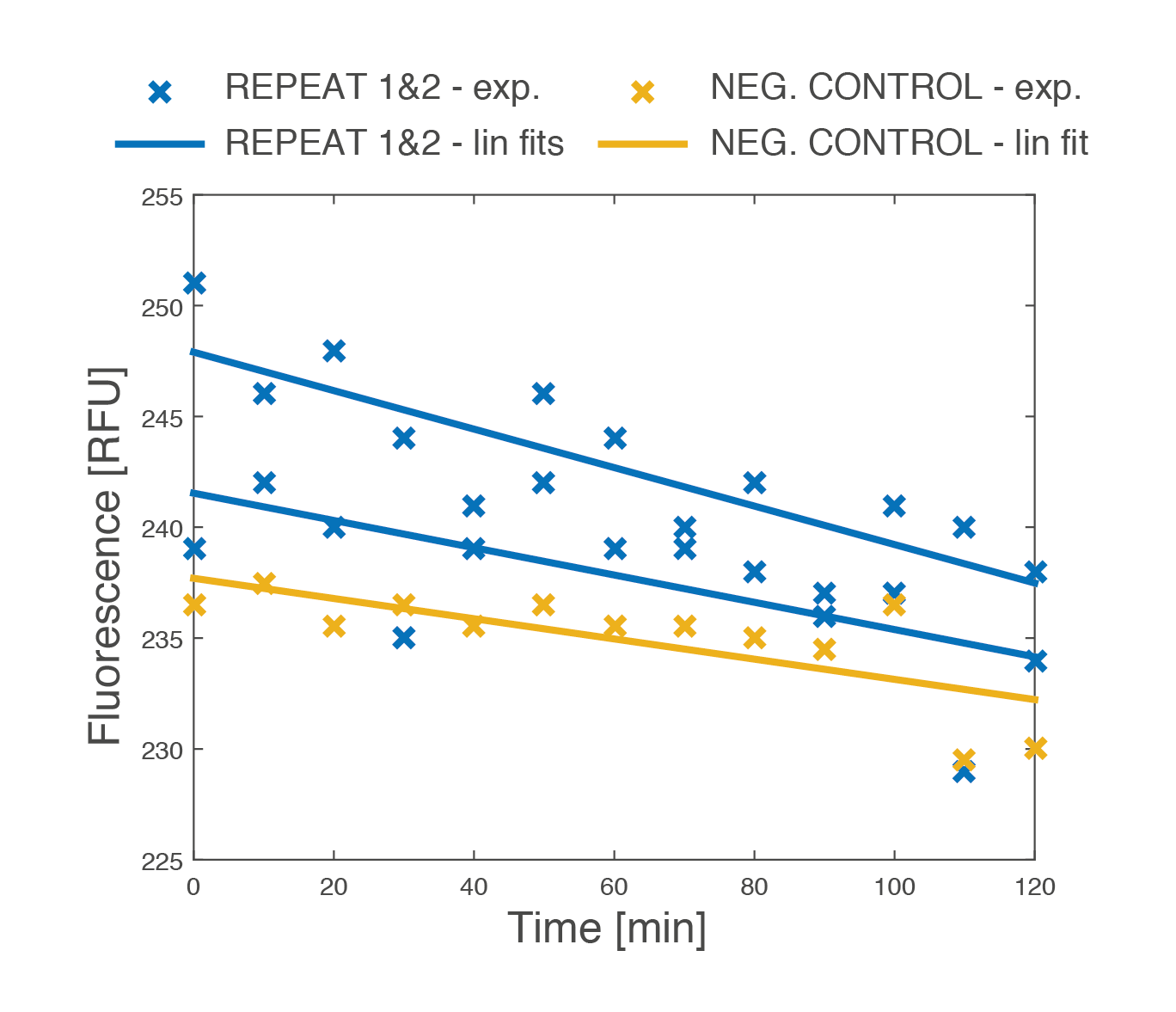
A final master experiment integrated the location tag and signalling functions. Signal transmission enabled by location tag display was shown in two strains constitutively displaying complimentary tags (EpCAM and anti-EpCAM). Strain A represented an IOD bound to a CTC: a transformed MATa strain displaying a fragment of the common epithelial CTC marker EpCAM and carrying a pheromone response reporter (GFP upstream of pFUS1). Strain B represented a second IOD that recognises the EpCAM marker and activates the IOD band response: a transformed MATa strain synthetically producing the S. cerevisiae pheromone. Localised signal transmission is difficult to quantify. Qualitatively fluorescence microscopy revealed greater intensity levels in observed aggregates. Microplate assays suggest modest activation of Strain A in mixed cultures when compared to background activation in pure cultures and controls. Mixed culture controls with strains lacking the location tags exhibited no activation.
It is important to note that modeling and microfluidics were extensively used to support the experimental work. Modeling proved robustness of simple signal transmission networks in a simulation setting with naturally occurring signaling noise. In-house replicated microfluidic chips provided the precise environment necessary to quantify the individual cell-cell interactions. Without these engineering tools, realization and validation of such a complex project would have been as impossible as the IOD band idea seemed at the outset.
Module 1 - Synthetic haploids
Abstract
The yeast pheromone pathway is a naturally present mechanism of signal transduction in yeast cells. In order for IODs to use mating pheromones as signaling molecules, each IOD has to have a mechanism for processing input signals. We would like to use the modified pheromone pathway in our IODs, however, in a diploid cell all components of the pathway are naturally switched-off. Therefore we designed synthetic haploid strains of both mating types that preserve the ability to process an extracellular signal via pheromone response pathway even after mating - in diploid state. As a result, IODs use the robust signaling pathway for signal processing.
Key Achievements
- Constructed a set of reporter promoters for yeast cells
- Characterized reporter promoters in all mating types
- Designed and materialized synthetic MATa and MATx strains
- Built a synthetic diploid strain with a functional yeast pheromone pathway
- Demonstrated the correct functionality of yeast pheromone pathway in synthetic diploids
Module 2 - Orthogonal signals and receptors
Abstract
In order to achieve a more complex behaviour of our IODs, each IOD needs to be able to communicate with others. Since the pheromone response pathway was used for signal transduction, we prepared several synthetic signals and receptors that couple to this pathway and allow our IODs to communicate without a cross-talk.
Key Achievements
- Constructed a set of yeast plasmids with different mating pheromones and their receptors and contributed to the Registry with 6 BioBricks
- Verified the correct coupling of the receptors to the yeast pheromone mating pathway
- Verified the correct expression and secretion of the different pheromones
- Showed the orthogonality of the used receptors and pheromones
Module 3 - Location tags
Abstract
To guarantee the ability of our system to recognize, bind, and respond to the presence of a tumour cell, we selected five antibody fragments to display on our yeast cells using the yeast display technology and monitor the cells' binding. Their expression was detected and monitored on a microfluidic chip with the use of antibody staining and fluorescence microscopy.
Key Achievements
- Expressed streptavidin, EpCAM, Anti-EpCAM scFv, c-Myc scFv and anti-HuA scFv on the surface of yeasts
- Monitored the dynamic binding of the displayed fragments of antibodies and corresponding markers
- Demonstrated compatibility of our yeast system and blood and functionality of the location tags in plasma
Module 4 - Modeling
Abstract
IOD systems function at both the intracellular and intercellular level. Intracellular biochemical reactions determine signaling activities and gene expression. Extracellular reactions include signaling molecule diffusion and cell movement with cell-cell interactions. At each level, models of various complexities are available. We selected minimalistic models that capture only the key design elements and integrated these models into a single simulator - CeCe. A subsequent simulation was used to study the robustness and efficiency of different signal transmission patterns in their ability to identify cells with specific marker profiles while minimizing false positives.
Key Achievements
- Developed a simulation environment CeCe to capture the complexity of cell-cell signal transmission
- Designed an IOD chemical reaction network model
- Developed a schematic architecture for conceptual modeling of signal transmission networks
- Designed a two IOD signal transmission network suitable for the IOD band
- Illustrated the robustness and efficiency of the IOD band design in CeCe simulations
Module 5 - Microfluidics
Abstract
Microfluidic devices were designed and fabricated to characterize the signal transmission in the developed IOD band system. Signal transmission between transmitting and receiving cells was characterized using spatially separated cell cultures inside a single microfluidic channel in conjunction with live fluorescence microscopy. Plasmids coding for a synthetic reporter protein were transformed into signal-receiving cells to show activation of its yeast pheromone pathway. The on-chip characterization was used to evaluate the signal transmission range and its evolution in time. In addition, special microfluidic topologies were designed and fabricated to test yeast-induced agglutination on-chip to lower the time and sample volume requirements. Agglutination tests were performed with synthetic yeast strains inducing blood agglutination by displaying the human antigen A antibody (anti-HuA) on its surface. The yeast strains were designed and synthesised by Module 3. The amount of blood necessary for the experiment did not exceed 5 μl.
Key Achievements
- Set of microfluidic devices fabricated by PDMS soft-lithography.
- Characterization of signal transmission range between wildtype MATa and MATx Saccharomyces cerevisiae cells.
- Dynamic characterisation of signal transmission between synthetic MATa and MATx Saccharomyces cerevisiae cells.
- Comparison with mathematical model of signal transmission mechanism and estimation of the activation threshold for different cell concentrations.
- Demonstrated yeast induced blood agglutination on-chip by human antigen A antibody (anti-HuA) displayed on cell surface by Yeast Surface Display.
